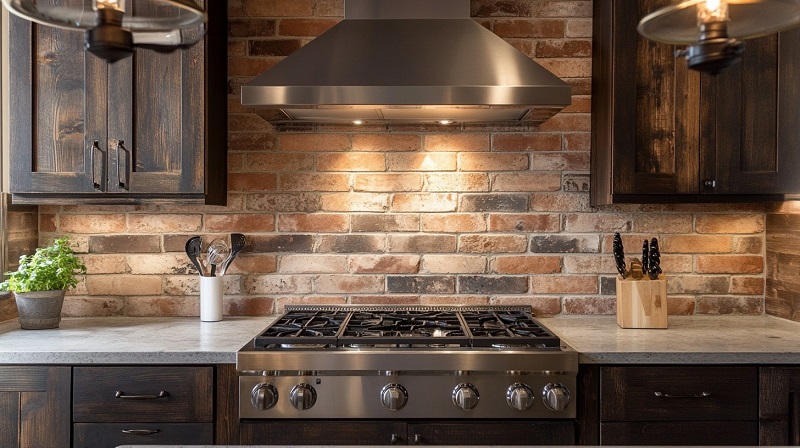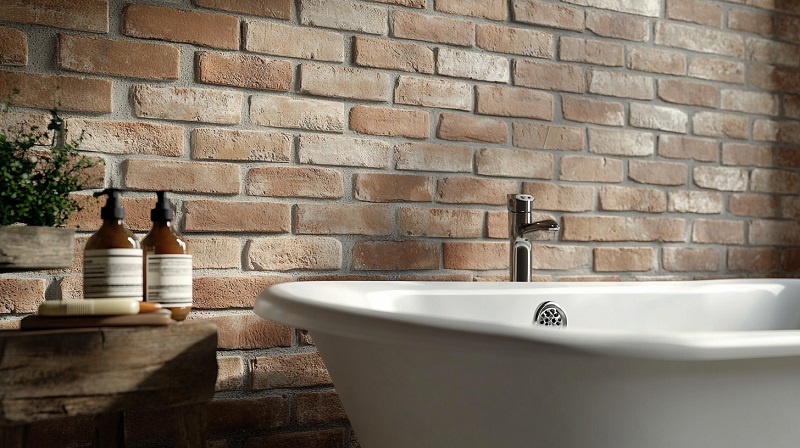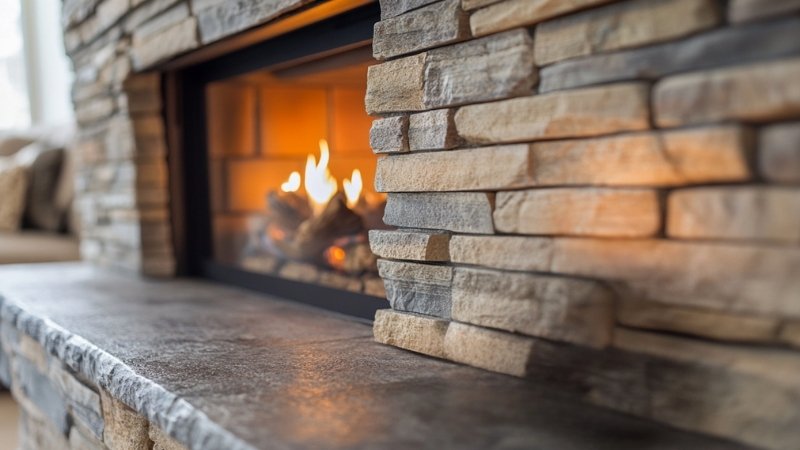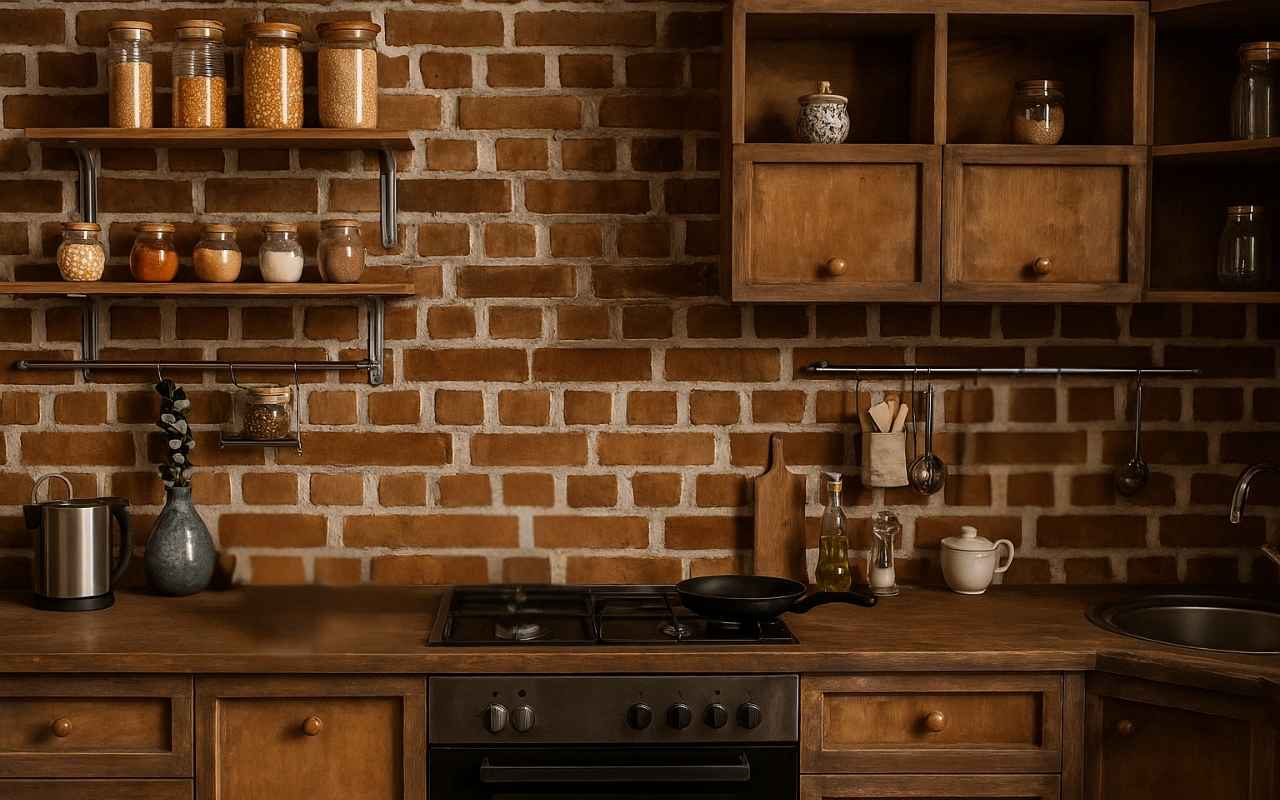Rustic design never feels forced. It invites warmth, comfort, and a sense of home that many people want but do not always know how to create. You do not need a log cabin or farmhouse to bring in that style.
Small changes and smart choices can bring a rustic touch into any room. It all comes down to materials, textures, and natural tones that work together without trying too hard.
Some people think rustic means rough or outdated. That idea misses the point. True rustic style uses honest, natural elements to build spaces that feel lived-in, grounded, and personal. It has nothing to do with trends or being polished. It works because it makes a room feel real.
The list below shares eight simple, creative tips. Each one offers a direct way to add rustic charm that feels genuine and fits into your space.
Use Thin Brick for Texture and Warmth
Thin brick creates a strong rustic foundation without heavy renovation. It captures the look of traditional masonry without the weight or depth of full brick. It works in modern apartments, small homes, and renovated spaces where structure limits full brick options.

Why Thin Brick Works
- Lightweight but authentic – Thin brick provides the aged, rugged surface of real brick without structural load. It fits indoor spaces easily.
- Textural contrast – Its uneven surface adds visual depth and tactile warmth that paint or drywall cannot replicate.
- Timeless character – Brick brings a visual link to older architecture. It anchors a room and adds a grounded, honest feel.
Where to Use Thin Brick
[su_table responsive=”yes”]
| Room | Use Case | Effect |
| Kitchen | Backsplash behind stove or counters | Adds contrast to smooth tile or metal |
| Entryway | Full wall or half-wall | Creates a strong first impression |
| Living Room | Fireplace surround or TV wall | Balances tech with tradition |
| Bathroom | Accent wall behind vanity | Adds warmth to a cold space |

[/su_table]
Installation and Finish Options
Surface Finish
- Matte or powdery finish gives a raw, older appearance
- Gloss sealants create a polished but still rustic surface
Layout Patterns
- Running bond: classic and familiar
- Stack bond: modern but still structured
- Herringbone: more visual detail and texture
Thin brick sets the tone for the rest of the room. Once it goes up, every other element, from fabrics to lighting, feels more grounded. It creates a rustic anchor that never feels artificial. If you are looking for high-quality thin bricks, check out Real Thin Brick.
Add Reclaimed Wood Beams to Expose Age and Character
Reclaimed wood beams introduce rustic charm through real history. Each piece shows its age through knots, nail holes, and weathered texture. The character comes built-in, not manufactured.
Where Beams Make the Most Impact
- Ceilings in living rooms – Span across a white ceiling to break up flatness and add warmth.
- Doorway headers or framing – Replace a standard frame with a thick reclaimed beam for instant rustic personality.
- Kitchen islands – Use wood beams as side trim or support structures for the countertop.
Choosing the Right Finish
Raw wood beams work best when left with visible grain. Some homeowners treat them with light stain or matte sealer. Avoid gloss or high-sheen finishes. Those remove the natural look and turn rustic into fake.
Choose Distressed Wood Furniture for Everyday Use
Distressed wood furniture tells a quiet story. Scratches, uneven surfaces, and aged finishes show use, not damage. These pieces feel familiar and welcoming.

Ideal Rooms for Distressed Furniture
- Dining Room – A long farmhouse table invites people to gather without worrying about wear.
- Bedroom – Nightstands or dressers with chipped corners and worn paint create an easy, lived-in atmosphere.
- Entryway – A distressed bench with storage combines function with rustic appeal.
Types of Finishes That Work
| Wood Type | Look | Best Feature |
| Pine | Soft, knotty, accepts stains well | Affordable and easy to distress |
| Oak | Grain-heavy, strong, deep-toned | Adds visual depth |
| Reclaimed barn wood | Already weathered, usually gray-toned | Authentic texture with history |
Add Linen and Burlap Textiles to Soften the Edges
Rough textures need balance. Linen and burlap give rustic spaces softness without removing their raw feel. They absorb light, add movement, and work across seasons. Unlike polished synthetics, these fabrics wrinkle and shift in ways that feel honest.
Where to Use Them
- Curtains – Use loose-weave linen in natural beige or ivory. Avoid linings or stiff pleats.
- Table Covers – Burlap or linen runners stretch across wood tables without hiding grain.
- Pillows and Throws – Add thick linen pillowcases or fringed burlap cushions on leather or canvas seating.
Add Natural Stone to Ground the Space

Stone keeps the rustic tone grounded. Unlike tiles made to look aged, real stone has imperfections, texture, and thermal mass. It anchors a room and ties other materials together.
Fireplaces
A stone fireplace sets the rustic tone for the entire living area. Use rough-cut stones in mixed tones to add variety. Avoid perfect symmetry. Let some edges remain jagged.
Bathrooms
Surround the tub or vanity with slate or tumbled marble. Pair with matte black fixtures or brushed brass.
Kitchen Accent Wall
Natural stone behind open shelving or above the stove adds weight and texture where tile feels too flat.
Add Blackened Iron or Wrought Metal Fixtures
Metal offers contrast in a rustic setting. It frames wood and soft materials, brings shape, and adds a historical layer. Blackened iron, aged bronze, or even rusted finishes bring an industrial edge that pairs well with soft textures.
Elements Where Metal Makes Sense
- Lighting fixtures – Iron chandeliers or sconces with candle-style bulbs fit rural spaces.
- Cabinet hardware – Swap shiny knobs for hammered or forged handles with patina.
- Furniture accents – Look for wood tables or shelves with metal braces or corner brackets.
Design Tips for Balance
- Keep metal matte – Avoid reflective finishes. Use rubbed or burnished surfaces.
- Use sparingly – A few strong metal pieces create contrast. Do not overfill the room.
- Match tones – Stick with one metal tone per space. Blackened iron works best in rustic rooms. Avoid mixing with polished chrome or gold.
Use Open Shelving with Wood and Metal Brackets

Open shelving brings a raw, utilitarian look that fits perfectly into rustic design. It replaces closed cabinetry with display areas that feel personal and useful. When made with thick wood and supported by dark metal brackets, open shelves do more than store. They shape the character of the room.
Start with reclaimed or lightly sanded planks. Leave edges rough or gently curved. Do not try to make them look machine-cut. Black steel or matte iron brackets should feel solid and functional. Avoid ornate curves or shiny finishes.
Place shelves in the kitchen for jars, mugs, and wooden cutting boards. In the bathroom, they hold folded towels, glass containers, and soapstone trays. Living rooms benefit from shelves filled with books, candles, and framed black-and-white photos.
Highlight Architectural Features to Show Age and Story
Old bones always matter more than decoration. Rustic design relies on revealing what most try to cover. Even one exposed surface makes the room feel rooted.
Reveal the Past, Do Not Replace It
- Let beams stay rough
- Expose brick behind drywall if it exists
- Strip trim down to raw wood
- Sand, but never polish
Every line, crack, or slope adds presence. Smooth spaces feel lifeless. Rough ones pull you in.
If Your Space Is New
Use illusion with purpose:
- Add faux ceiling beams using salvaged timber
- Apply textured limewash paint on smooth plaster
- Frame windows with reclaimed wood boards
- Insert a simple archway with uneven plaster finish
The point is not to fake age. It is to suggest weight and memory. Nothing should feel new unless it earns its place beside the old.
Conclusion
Rustic design does not come from themes. It comes from truth. Every room can hold that truth through material, texture, and choice. No need for expensive furniture or coordinated sets. What matters is how things feel, not how they match.
Use thin brick to ground your space. Let reclaimed wood show its age. Add softness with linen, and contrast with metal. Open your storage to view, not hide. Show beams, old trim, and stone without apology. Then add one object that carries real weight.
Each tip here stands on its own. Together, they shape a full room without force. You control how far to go. Keep it simple. Keep it honest. Rustic style works best when it reflects what you already have.
